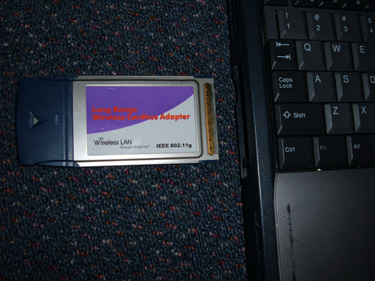Basic Network guide |
|
Wireless networks.
Required hardware:- Wireless router (Or Wireless access point, also called a WAP)
- Wireless network card

A Wireless router (note the aerial)

Laptop Wireless card - Some laptops have them internally.
Wireless (Wi-fi) setups work very similar to wired, except that instead of connecting via a cable, it uses radio transmissions in the 2.4Ghz range - the same as Bluetooth accessories for mobile phones, and some cordless landline phones.
The setup for a Wi-fi network may differ depending on the network card you own, but is usually a variation of the following:
- Scan for wireless networks
- Choose the network you wish to join (You could access your neighbor's network, for example)
- Enter any password/keycodes required (this depends if your wireless network has security enabled)
- Enjoy your wireless connection
Some people also don't use encryption, mistakenly thinking "why would anyone hack MY internet?" Think of your neighbours or anyone within 200m of your house; they can easily leech off your connection [note to muss: assuming this is what you mean? or something in there that says what you mean]. I myself have walked around town with my laptop, and I have used other people's internet hundreds of metres from their homes. You should always enable security, even if it's just to stop passers-by from accessing your network.
Notes on Wi-fi hacking/encryption
WPA and WPA2 are the best encryption methods if your hardware supports it. Experts using Linux can hack a WEP 64 or WEP 128 code in less than 15 minutes, and gain access to your network.
Someone who gains access to your network doesn’t just get the internet - they are on your NETWORK, exactly the same as if they came in and plugged a cable into your router. If you have shared files and folders over the network, they CAN access these, and depending on how you set them up, possibly even delete those files.
These people CANNOT access files you have not shared, however. If you use a wireless network, think ahead and only share files when you want them accessed, and un-share them when done.
Advanced security options and methods to make wireless networks more secure will be expanded upon in a future revision to this article.
Mar 20th, 2025 07:21 EDT
change timezone
Latest GPU Drivers
New Forum Posts
- 7900xt let's see what it can do! (2)
- PCI 4.0 16x slot reported as a PCI 5.0 8x with the AMD 9070 XT Reaper GPU (36)
- Is RX 9070 VRAM temperature regular value or hotspot? (41)
- Your PC ATM (35277)
- Asrock z590 oc formula best cpu and memory speeds? (16)
- HalfLife2 RTX Demo Is out! (226)
- Intel Core i9-14900KS vs. Intel Core Ultra 9 285K (23)
- Old Gamer Memory Upgrade Worth It? (27)
- SLI is really not Dead if you Have a SLI rig (85)
- What's your latest tech purchase? (23370)
Popular Reviews
- ASRock Radeon RX 9070 XT Taichi OC Review - Excellent Cooling
- Corsair SF750 750 W Review
- Sapphire Radeon RX 9070 XT Nitro+ Review - Beating NVIDIA
- AMD Ryzen 9 9950X3D Review - Great for Gaming and Productivity
- be quiet! Pure Base 501 LX Review
- MSI GeForce RTX 5070 Gaming Trio OC Review
- XFX Radeon RX 9070 XT Mercury OC Magnetic Air Review
- ASUS Radeon RX 9070 TUF OC Review
- AVerMedia Core Go & Elite Go Review
- ASUS GeForce RTX 5090 TUF Review
Controversial News Posts
- NVIDIA GeForce RTX 50 Cards Spotted with Missing ROPs, NVIDIA Confirms the Issue, Multiple Vendors Affected (519)
- AMD RDNA 4 and Radeon RX 9070 Series Unveiled: $549 & $599 (260)
- AMD Mentions Sub-$700 Pricing for Radeon RX 9070 GPU Series, Looks Like NV Minus $50 Again (250)
- NVIDIA Investigates GeForce RTX 50 Series "Blackwell" Black Screen and BSOD Issues (244)
- AMD Radeon RX 9070 and 9070 XT Official Performance Metrics Leaked, +42% 4K Performance Over Radeon RX 7900 GRE (195)
- AMD Radeon RX 9070-series Pricing Leaks Courtesy of MicroCenter (158)
- MSI Doesn't Plan Radeon RX 9000 Series GPUs, Skips AMD RDNA 4 Generation Entirely (142)
- Microsoft Introduces Copilot for Gaming (123)